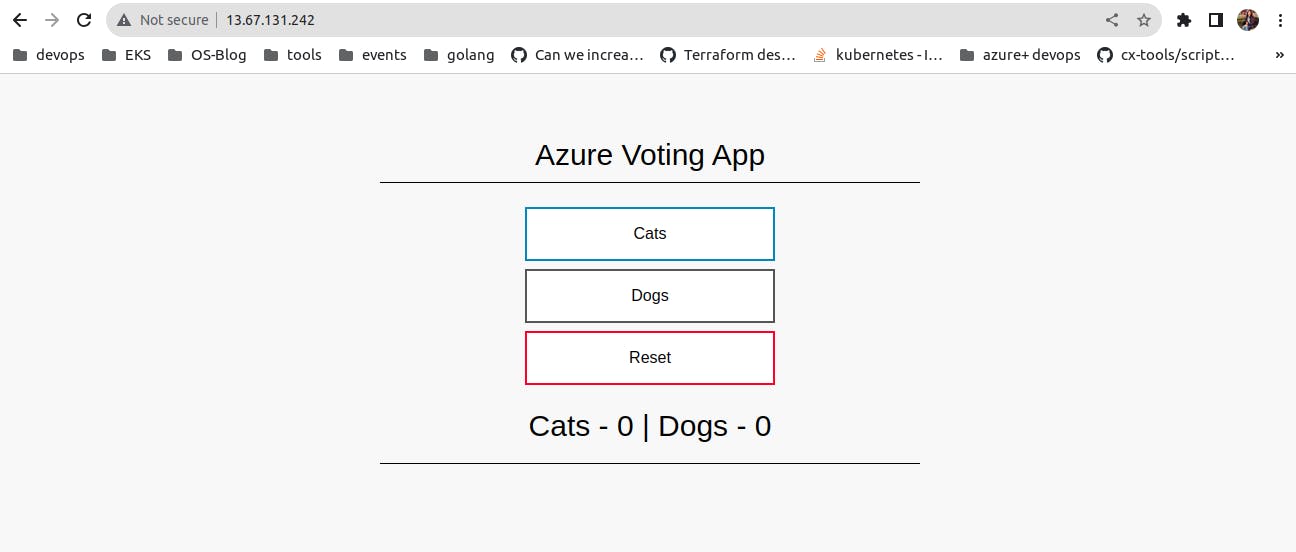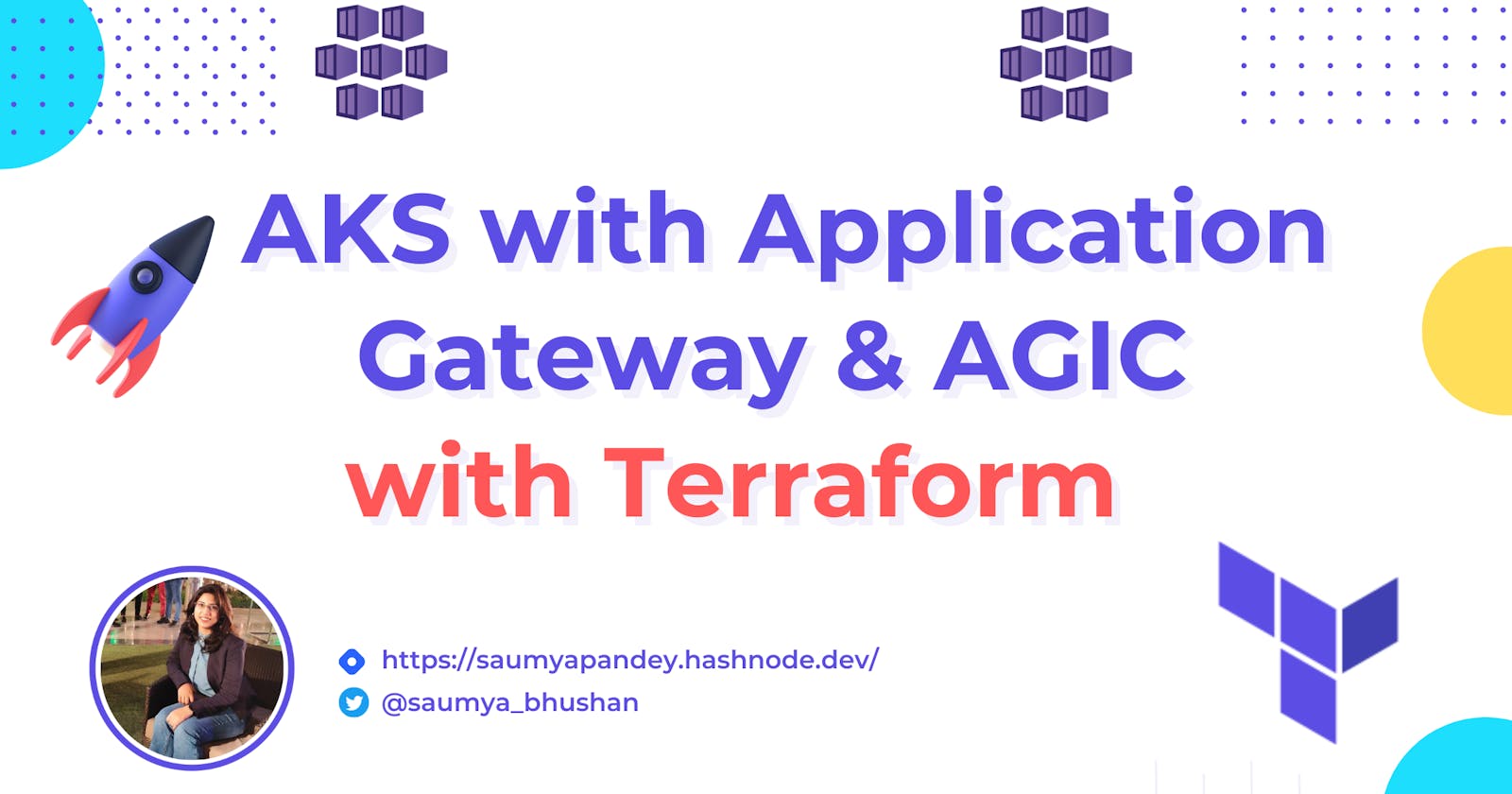I'm writing this blog about a recent difficulty I encountered while setting up an AKS cluster. It revolved around being unable to manage the Application Gateway linked to it. A little sneak peek: the issue had to do with identity and permissions.
What is AGIC (Application Gateway IngressController)?
The Application Gateway Ingress Controller (AGIC) is a Kubernetes application, which makes it possible for Azure Kubernetes Service (AKS) customers to leverage Azure's native Application Gateway L7 load-balancer to expose cloud software to the Internet. AGIC monitors the Kubernetes cluster it's hosted on and continuously updates an Application Gateway so that selected services are exposed to the Internet. You can read more about it here.
Prerequisite and scope
In this blog post, we will delve into exploring the utilization of Terraform to accomplish the following tasks:
✅Create a resource group
✅Create a new application gateway
✅Create a new AKS cluster with AGIC add-on enabled
✅Deploy a sample application using AGIC for ingress on the AKS cluster
✅Check that the application is reachable through application gateway
You need to have one vnet and within that atleast two subnets already created in azure . One subnet for AKS cluster and another one for application gateway.
Lets explore the terraform code .
Implement the Terraform code
Create a directory in which to test the sample Terraform code and make it the current directory.
Create a file named
providers.tfand insert the following code.terraform { required_version = "~> 1.2" required_providers { azurerm = { source = "hashicorp/azurerm" version = "~> 3.0" } } } provider "azurerm" { features {} }Create a file named
app-gateway.tfand insert the following code.resource "azurerm_resource_group" "rg" { name = var.resource_group_name location = var.resource_group_location } data "azurerm_subnet" "appgwsubnet" { name = var.application_gateway_subnet_name virtual_network_name = var.vnet_name resource_group_name = var.vnet_resource_group_name } resource "azurerm_public_ip" "test" { name = "publicIp1" location = azurerm_resource_group.rg.location resource_group_name = azurerm_resource_group.rg.name allocation_method = "Static" sku = "Standard" tags = var.tags } resource "azurerm_application_gateway" "network" { name = var.app_gateway_name resource_group_name = azurerm_resource_group.rg.name location = azurerm_resource_group.rg.location sku { name = var.app_gateway_sku tier = "Standard_v2" capacity = 2 } gateway_ip_configuration { name = "appGatewayIpConfig" subnet_id = data.azurerm_subnet.appgwsubnet.id } frontend_port { name = local.frontend_port_name port = 80 } frontend_port { name = "httpsPort" port = 443 } frontend_ip_configuration { name = local.frontend_ip_configuration_name public_ip_address_id = azurerm_public_ip.test.id } backend_address_pool { name = local.backend_address_pool_name } backend_http_settings { name = local.http_setting_name cookie_based_affinity = "Disabled" port = 80 protocol = "Http" request_timeout = 1 } http_listener { name = local.listener_name frontend_ip_configuration_name = local.frontend_ip_configuration_name frontend_port_name = local.frontend_port_name protocol = "Http" } request_routing_rule { name = local.request_routing_rule_name rule_type = "Basic" http_listener_name = local.listener_name backend_address_pool_name = local.backend_address_pool_name backend_http_settings_name = local.http_setting_name priority = 100 } tags = var.tags depends_on = [azurerm_public_ip.test] lifecycle { ignore_changes = [ backend_address_pool, backend_http_settings, request_routing_rule, http_listener, probe, tags, frontend_port ] } }Create a file named
aks.tfand insert the following code.data "azurerm_subnet" "akssubnet" { name = var.aks_subnet_name virtual_network_name = var.vnet_name resource_group_name = var.vnet_resource_group_name } resource "azurerm_log_analytics_workspace" "aks_workspace" { name = var.workspace location = azurerm_resource_group.rg.location resource_group_name = azurerm_resource_group.rg.name } resource "azurerm_kubernetes_cluster" "aks" { name = var.cluster_name kubernetes_version = var.kubernetes_version location = var.location resource_group_name = azurerm_resource_group.rg.name dns_prefix = var.cluster_name private_cluster_enabled = true http_application_routing_enabled = false azure_policy_enabled = true private_cluster_public_fqdn_enabled = var.private_cluster_public_fqdn_enabled oms_agent { log_analytics_workspace_id = azurerm_log_analytics_workspace.aks_workspace.id } default_node_pool { name = var.node_pool_name node_count = var.system_node_count vm_size = var.vm_size type = var.aks_node_pool_type enable_auto_scaling = var.enable_auto_scaling os_disk_size_gb = var.os_disk_size_gb vnet_subnet_id = data.azurerm_subnet.akssubnet.id } ingress_application_gateway { gateway_id = azurerm_application_gateway.network.id } azure_active_directory_role_based_access_control { managed = true azure_rbac_enabled = true } identity { type = var.identity_type } network_profile { network_plugin = var.network_plugin load_balancer_sku = var.loadbalancer_sku network_policy = var.network_policy } depends_on = [ azurerm_application_gateway.network ] } resource "azurerm_log_analytics_solution" "container_insights" { solution_name = var.container_insights location = azurerm_resource_group.rg.location resource_group_name = azurerm_resource_group.rg.name workspace_resource_id = azurerm_log_analytics_workspace.aks_workspace.id workspace_name = azurerm_log_analytics_workspace.aks_workspace.name plan { publisher = var.aks_publisher product = var.aks_product } }Create a file named
locals.tfand insert the following code.# Locals block for hardcoded names locals { backend_address_pool_name = "${var.vnet_name}-beap" frontend_port_name = "${var.vnet_name}-feport" frontend_ip_configuration_name = "${var.vnet_name}-feip" http_setting_name = "${var.vnet_name}-be-htst" listener_name = "${var.vnet_name}-httplstn" request_routing_rule_name = "${var.vnet_name}-rqrt" app_gateway_subnet_name = data.azurerm_subnet.appgwsubnet.name }Create a file named
roles.tfand insert the following code.resource "azurerm_role_assignment" "Network_Contributor_subnet" { scope = data.azurerm_subnet.appgwsubnet.id role_definition_name = "Network Contributor" principal_id = azurerm_kubernetes_cluster.aks.ingress_application_gateway[0].ingress_application_gateway_identity[0].object_id } resource "azurerm_role_assignment" "rg_reader" { scope = azurerm_resource_group.rg.id role_definition_name = "Reader" principal_id = azurerm_kubernetes_cluster.aks.ingress_application_gateway[0].ingress_application_gateway_identity[0].object_id } resource "azurerm_role_assignment" "app-gw-contributor" { scope = azurerm_application_gateway.network.id role_definition_name = "Contributor" principal_id = azurerm_kubernetes_cluster.aks.ingress_application_gateway[0].ingress_application_gateway_identity[0].object_id }Create a file named
variables.tfand insert the following code.variable "resource_group_location" { default = "centralus" description = "Location of the resource group." } variable "app_gateway_name" { description = "Name of the Application Gateway" default = "ApplicationGateway1" } variable "app_gateway_sku" { description = "Name of the Application Gateway SKU" default = "Standard_v2" } variable "app_gateway_tier" { description = "Tier of the Application Gateway tier" default = "Standard_v2" } variable "tags" { type = map(string) default = { source = "terraform" } } variable "resource_group_name" { type = string description = "RG name in Azure" default = "rg-test" } variable "location" { type = string description = "Resources location in Azure" default = "centralus" } variable "cluster_name" { type = string description = "AKS name in Azure" default = "test-aks" } variable "kubernetes_version" { type = string description = "Kubernetes version" default = "1.26.3" } variable "system_node_count" { type = number description = "Number of AKS worker nodes" default = 1 } variable "vm_size" { type = string description = "size of node pool" default = "Standard_DS2_v2" } variable "node_pool_name" { type = string description = "node pool name" default = "testpool" } variable "enable_auto_scaling" { type = string description = "auto scaling node pool" default = "false" } variable "aks_node_pool_type" { type = string description = "aks_node_pool" default = "VirtualMachineScaleSets" } variable "os_disk_size_gb" { type = number description = "disk size in GB" default = 30 } variable "network_plugin" { type = string description = "Network plugin " default = "azure" } variable "network_policy" { type = string description = "azure network policy " default = "azure" } variable "loadbalancer_sku" { type = string description = "specified loadbalancer sku type" default = "standard" } variable "identity_type" { type = string description = "identity type" default = "SystemAssigned" } variable "workspace" { type = string description = "The full name of the Log Analytics workspace with which the solution will be linked." default = "aks-workspace" } variable "container_insights" { type = string description = "name of the log analytics solution " default = "AksContainerInsights" } variable "aks_publisher" { type = string description = "The publisher of the solution.For example Microsoft.Changing this forces a new resource to be created." default = "Microsoft" } variable "aks_product" { type = string description = "The product name of the solution.For example OMSGallery/Containers.Changing this forces a new resource to be created." default = "aksContainerInsights" } variable "aks_subnet_name" { description = "Name of AKS Subnet." default = "aks" type = string } variable "vnet_name" { description = "Name of VNet." default = "test-vnet" type = string } variable "vnet_resource_group_name" { description = "Name of theVnet resource group." default = "vnet-rg" type = string } variable "private_cluster_public_fqdn_enabled" { type = bool description = "Disable a public FQDN on a new AKS cluster" default = false } variable "application_gateway_subnet_name" { type = string description = "name of the subnet where application gateway resides" default = "default" }You can either change the default values or create a
.tfvarsfile where you can pass the values of your variables for this iac.Create a file named
outputs.tfand insert the following code.output "aks_id" { value = azurerm_kubernetes_cluster.aks.id } output "cluster_name" { value = azurerm_kubernetes_cluster.aks.name } output "networkprofile" { value = azurerm_kubernetes_cluster.aks.network_profile } output "private_cluster_enabled" { value = azurerm_kubernetes_cluster.aks.private_cluster_enabled } output "role_based_access_control_enabled" { value = azurerm_kubernetes_cluster.aks.role_based_access_control_enabled } output "azurerm_log_analytics_workspace" { value = azurerm_log_analytics_workspace.aks_workspace.name } output "azurerm_log_analytics_solution" { value = azurerm_log_analytics_solution.container_insights.solution_name } resource "local_file" "kubeconfig" { depends_on = [azurerm_kubernetes_cluster.aks] filename = "kubeconfig" content = azurerm_kubernetes_cluster.aks.kube_config_raw } output "application_ip_address" { value = azurerm_public_ip.test.ip_address }
Init , Plan and Apply
Run terraform init to initialize the Terraform deployment.
Run terraform plan to create an execution plan.
Run terraform apply to apply the execution plan to your cloud infrastructure.
Verify the results: Test the Kubernetes cluster
Connect with your Kubernetes cluster. Check the accessibility by kubectl get nodes command or any other command for aks.
You can test the ingress with a fun voting game from Microsoft deployed with this manifest. A big thanks to Thomas Thornton and Microsoft Docs for the great deployment.yaml . Here is the deployment manifest.
apiVersion: apps/v1
kind: Deployment
metadata:
name: azure-vote-back
spec:
replicas: 1
selector:
matchLabels:
app: azure-vote-back
template:
metadata:
labels:
app: azure-vote-back
spec:
nodeSelector:
"kubernetes.io/os": linux
containers:
- name: azure-vote-back
image: mcr.microsoft.com/oss/bitnami/redis:6.0.8
env:
- name: ALLOW_EMPTY_PASSWORD
value: "yes"
resources:
requests:
cpu: 100m
memory: 128Mi
limits:
cpu: 250m
memory: 256Mi
ports:
- containerPort: 6379
name: redis
---
apiVersion: v1
kind: Service
metadata:
name: azure-vote-back
spec:
ports:
- port: 6379
selector:
app: azure-vote-back
---
apiVersion: apps/v1
kind: Deployment
metadata:
name: azure-vote-front
spec:
replicas: 1
selector:
matchLabels:
app: azure-vote-front
template:
metadata:
labels:
app: azure-vote-front
spec:
nodeSelector:
"kubernetes.io/os": linux
containers:
- name: azure-vote-front
image: mcr.microsoft.com/azuredocs/azure-vote-front:v1
resources:
requests:
cpu: 100m
memory: 128Mi
limits:
cpu: 250m
memory: 256Mi
ports:
- containerPort: 80
env:
- name: REDIS
value: "azure-vote-back"
---
apiVersion: v1
kind: Service
metadata:
name: azure-vote-front
spec:
type: LoadBalancer
ports:
- port: 80
selector:
app: azure-vote-front
---
apiVersion: networking.k8s.io/v1
kind: Ingress
metadata:
name: azure-vote-front
annotations:
kubernetes.io/ingress.class: azure/application-gateway
spec:
rules:
- http:
paths:
- path: /
pathType: Prefix
backend:
service:
name: azure-vote-front
port:
number: 80
Run kubectl apply -f deployment.yaml
You can get the application_ip_address from output . Go to your browser and paste this ip address . You will be able to see your application running .

Summary
Setting up the Application Gateway Ingress Controller on an existing Application Gateway can be a challenging task if the necessary permissions haven't been properly configured. Resolving these issues can lead to extended periods of troubleshooting, but my aim is that I've now helped you save valuable time and frustration! 🤓

